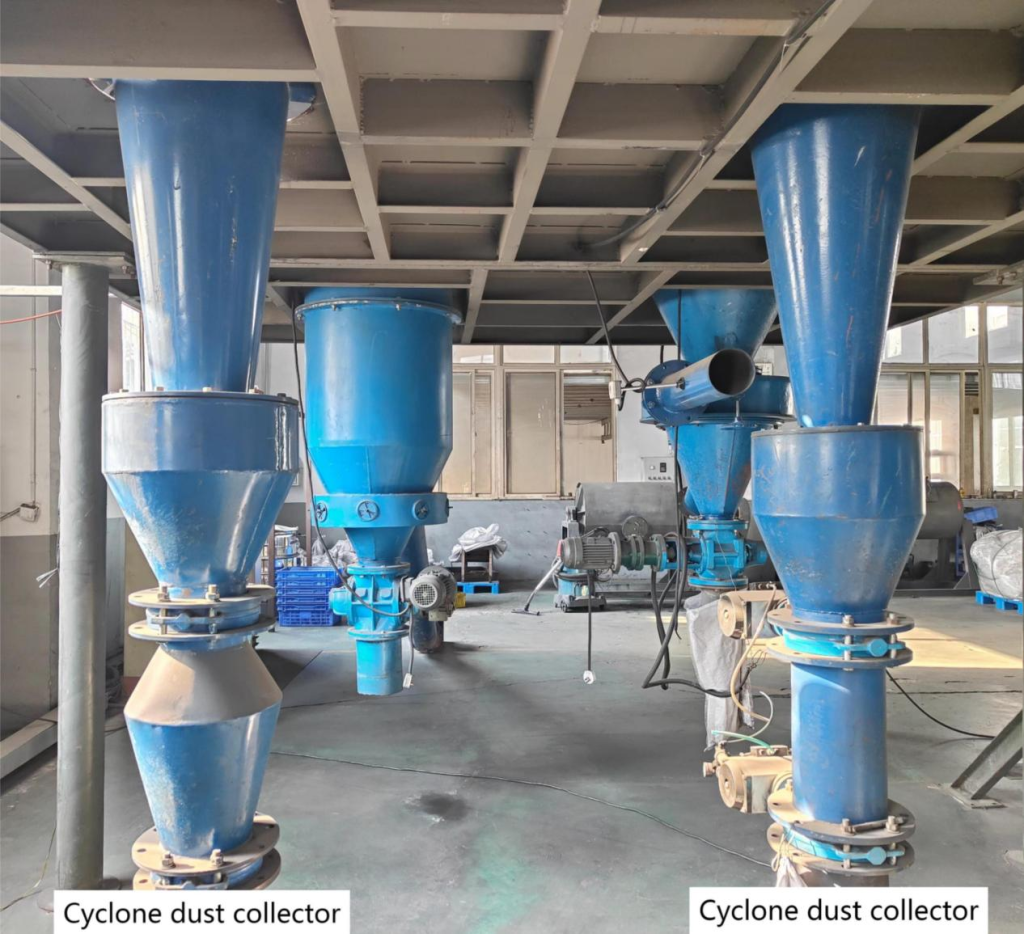परिचय
अपशिष्ट गैस उपचार एक व्यापक रूप से इस्तेमाल की जाने वाली पर्यावरण संरक्षण तकनीक है, इसका उपयोग औद्योगिक उत्पादन के दौरान उत्पन्न अपशिष्ट गैस का उपचार करने और प्रदूषित हवा को उत्सर्जन मानकों के अनुरूप बनाने के लिए किया जाता है। धूल हटाना अपशिष्ट गैस उपचार का एक महत्वपूर्ण हिस्सा है। इसका मुख्य उपकरण चक्रवात है धूल संग्रहित करने वालाचक्रवात धूल कलेक्टर के डिजाइन का विश्लेषण करके, हम विभिन्न कार्य स्थितियों के लिए उपयुक्त सूत्र प्राप्त कर सकते हैं, और यह व्यावहारिक परियोजना संचालन के लिए सहायक होगा। चक्रवात धूल संग्राहक के डिजाइन कारक

① गैस वेग
धूल प्रणाली में गैस की गति मुख्य रूप से किसके द्वारा प्राप्त होती है? वेग वायु प्रवाह का। सिलेंडर की स्पर्शरेखा दिशा के साथ गैस का वेग धीरे-धीरे बढ़ता है, और जब वायु प्रवाह शंकु के शीर्ष पर पहुंचता है तो अधिकतम मूल्य पर पहुंच जाता है। 10 मिमी से अधिक आकार वाले कणों के लिए, गैस का वेग 35 मीटर/सेकंड तक पहुंच सकता है; 10 मिमी से कम आकार वाले कणों के लिए, गैस का वेग लगभग 25 मीटर/सेकंड है। 25 मीटर/सेकंड-35 मीटर/सेकंड वह अधिकतम दक्षता सीमा है जिसे कई डिजाइनरों ने धूल कलेक्टरों को डिजाइन करते समय अपनाया है।
② हवा का दबाव
धूल प्रणाली का कुल दबाव मुख्य रूप से वायु इनलेट के स्थिर दबाव, निकास बंदरगाह के गतिशील दबाव और प्रतिरोध से बना होता है। प्रतिरोध सिलेंडर के आकार और खुरदरेपन से निर्धारित होता है। निश्चित तापमान पर, गैस का निरपेक्ष दबाव P, आयतन प्रवाह q के व्युत्क्रमानुपाती होता है, अर्थात, P1/q1=k1, यहाँ k1 आनुपातिक गुणांक है। चूँकि वायु इनलेट का स्थिर दबाव प्रतिरोध के हिस्से को दूर कर सकता है, इसलिए केन्द्रापसारक धूल कलेक्टर का कुल दबाव अक्षीय प्रवाह प्रकार की तुलना में कम होता है।
③ पहनने का प्रतिरोध
चक्रवात धूल कलेक्टर का पहनने का प्रतिरोध सीधे उपकरण के सेवा जीवन को प्रभावित करता है। आम तौर पर, कण जितने बड़े होते हैं, घनत्व उतना ही अधिक होता है, और सामग्री की सतह जितनी अधिक चिपचिपी होती है, पहनने का प्रतिरोध उतना ही अधिक होता है। इसलिए, चक्रवात धूल कलेक्टर को डिजाइन करते समय, धूल के भौतिक गुणों और धूल से लदी गैस के गुणों पर विचार करना आवश्यक है।
④ कण आकार
कण का आकार कण के लिए बुनियादी विशेषता मापदंडों में से एक है। हवा में ठोस कणों को एक उदाहरण के रूप में लेते हुए, कण आकार एक निश्चित कण आकार सीमा के भीतर ठोस कणों की मात्रा के अनुपात को उस कण आकार के कणों की कुल मात्रा से संदर्भित करता है। ठोस कणों का आकार न केवल अधिशोषक के विशिष्ट सतह क्षेत्र को प्रभावित करता है, बल्कि अधिशोषण और उत्प्रेरक की प्रक्रिया को भी प्रभावित करता है। इसलिए, चक्रवात धूल कलेक्टर को डिजाइन करते समय धूल के कण आकार वितरण पर विचार करने की आवश्यकता है।
चक्रवात धूल संग्राहक के लिए डिजाइन सूत्र का सारांश
1. निस्पंदन दर: G = 200 ~ 800L / मिनट
2. गैस प्रवाह दर: Q1 = (38 – P1 / K1) × V1
3. गैस लोड: P2 = (200-600 Pa)
4. पृथक्करण दक्षता: e = 95% ~ 99%
5. धूल संग्रहण दक्षता: φ = 100% ~ 98%
6. दबाव में गिरावट: △p = 0.396 KPa ~ 0.684 KPa
7. स्वीकार्य दबाव हानि: △p<0.296KPa
व्यावहारिक अनुप्रयोग में, चक्रवात धूल कलेक्टर को आमतौर पर साथ जोड़ा जाता है चक्की या वर्गीकरणकर्ता के दौरान उत्पन्न धूल को प्रभावी ढंग से संभालने और इकट्ठा करने के लिए पिसाई या वर्गीकृत. क़िंगदाओ एपिक पाउडर मशीनरी कं, लिमिटेडपाउडर प्रसंस्करण उपकरण का एक पेशेवर निर्माता है। क़िंगदाओ एपिक के पास विभिन्न प्रकार के पल्वराइज़र के उत्पादन में समृद्ध अनुभव है, वर्गीकरणकर्ता और धूल संग्राहकये उत्पाद घरेलू और विदेशी ग्राहकों के बीच लोकप्रिय हैं।
यदि आपकी कोई संबंधित आवश्यकता या प्रश्न हों तो कृपया संपर्क करें कर्मचारी क़िंगदाओ महाकाव्य से, वे हमेशा आपकी सेवा में हैं।

